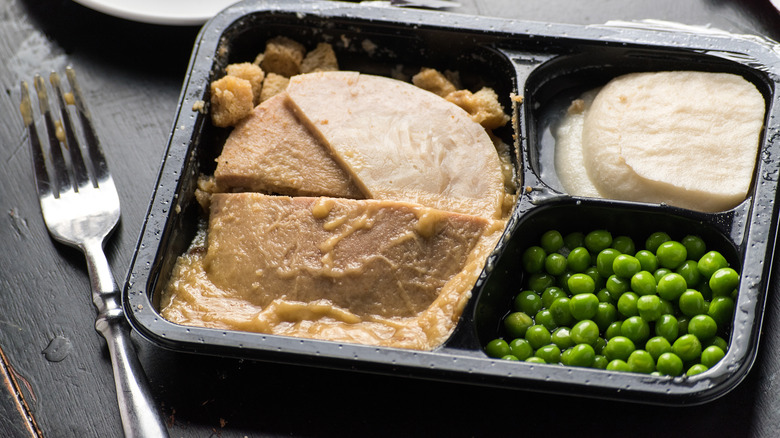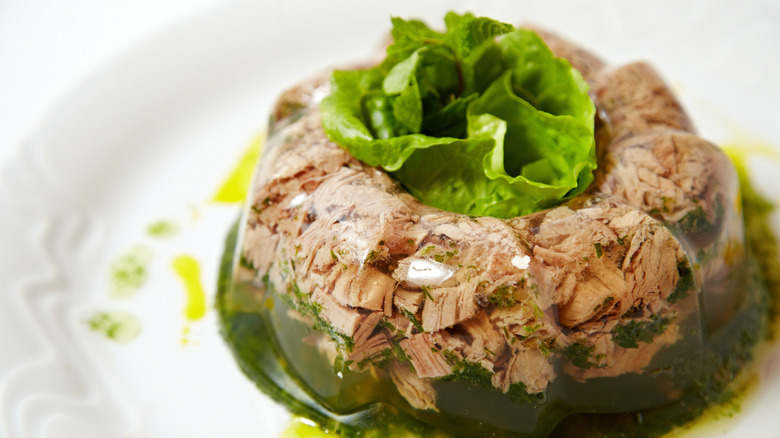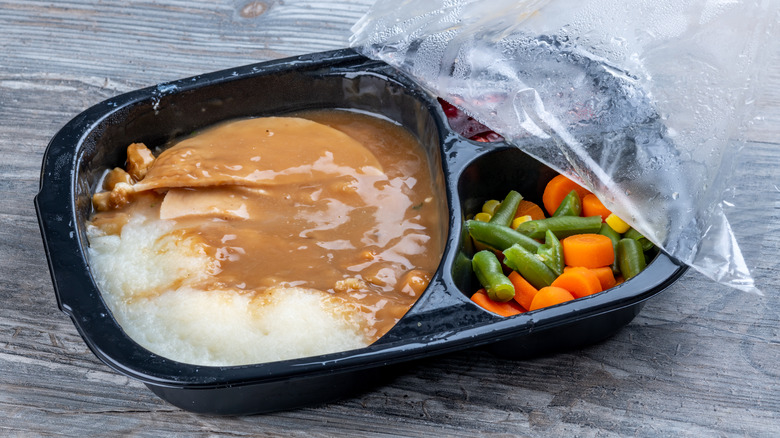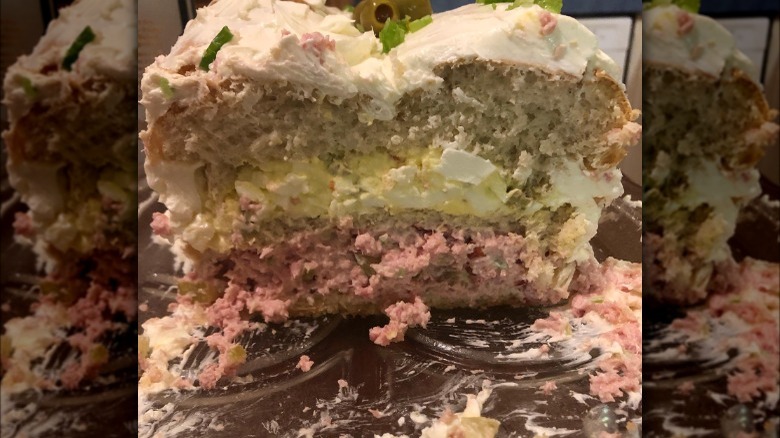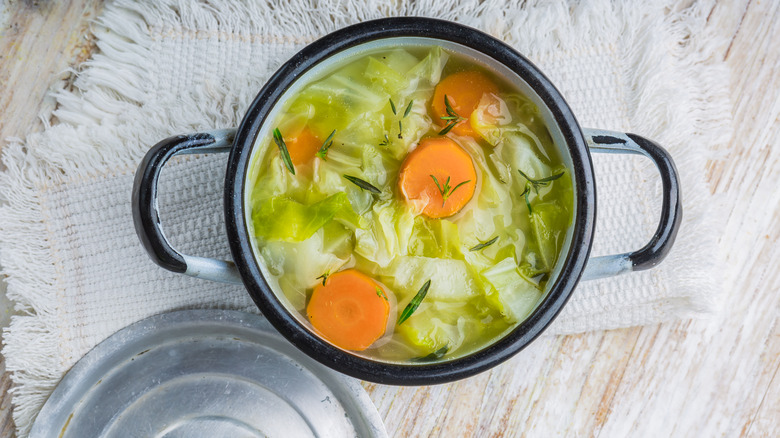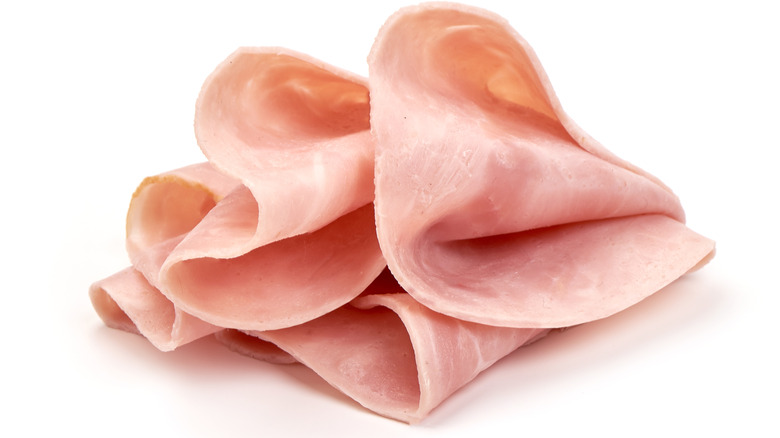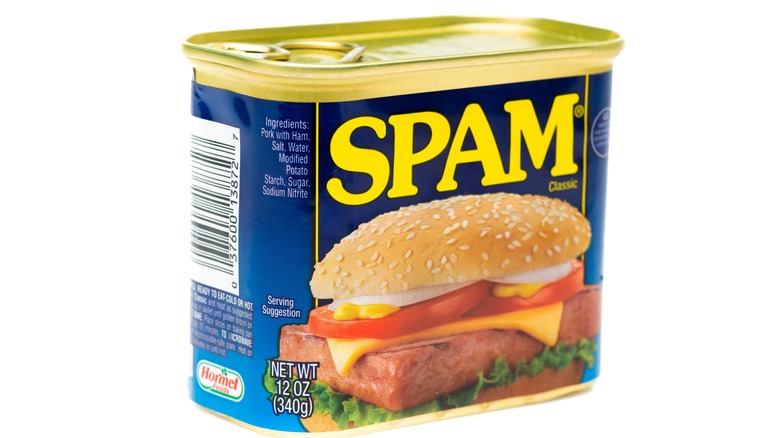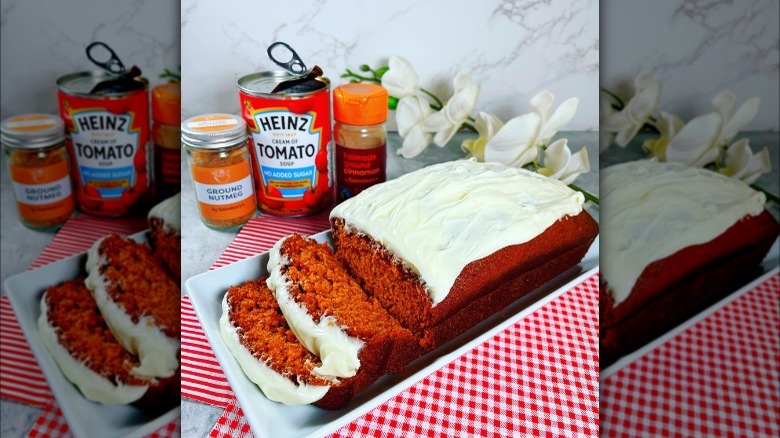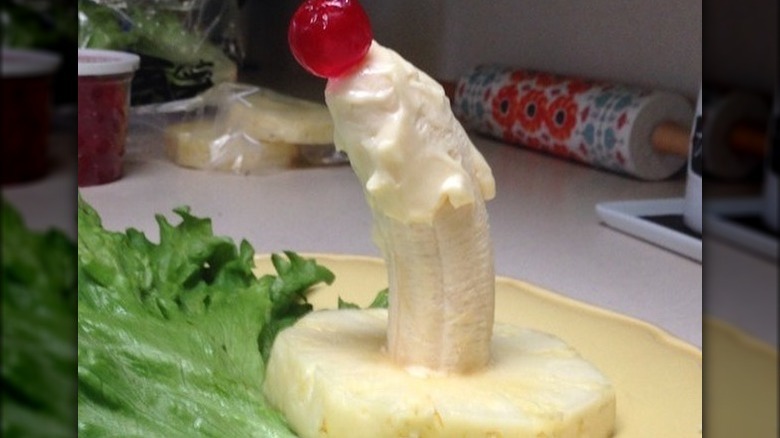9 Foods From The 1950s That We're Not Necessarily Missing
A lot of modern American cuisine got its start in the 1950s. It was at this point that a lot of wartime technology was converted for domestic use, and general economic prosperity reigned in select American households. Moreover, there were a lot of babies being born that needed to be fed. The country, and its food, transformed into something new over the course of this period. The ripple effects can be felt to this day.
That's all well and good. But there are plenty of postwar foods that simply do not translate to today's tastes. In the '50s, convenience and processing were highly valued elements of any meal. In contemporary culture, however, these are often perceived as negative attributes for a food to have. Whether or not this is accurate or fair remains a question of both perception and taste, of course. No food can truly and objectively be called disgusting — but people can, en masse, be disgusted by particular foods. In that spirit, we're here to take a look at the 1950s' most stomach-churning bites. Midcentury gourmands might have loved these meals, but modern foodies aren't necessarily missing them.
1. Jell-O salads
Jell-O salad is the first thing that comes to mind when one thinks of questionable '50s foods. There's just something about the sight of meat and other foods suspended in brightly colored gelatin that often makes the stomach churn. However, Jell-O salad has noble roots. In fact, some consider the wobbly dish nothing less than an American icon and historical artifact. Jell-O salads, and associated aspics, have long been part of American cuisine, but in the '50s, they took off. These salads, which often used leftovers, became a way for housewives to simultaneously avoid food waste and make a quick meal with a personal touch. With the right mold, a clever cook could even transform a Jell-O salad into one of a thousand unique shapes.
So, how did we start getting grossed out? Some hypothesize that the salad's mix of textures is what caused it to become so off-putting. Jell-O is cold, slimy, and somewhere between liquid and solid. Suspend some crunchy, chewy, or meaty ingredients in that slippery gelatin, and you have a dish that's pretty hard to chew on. The blend of flavors isn't ideal either: Who wants their sweet, tangy lime Jell-O suddenly interrupted by a chunk of savory tuna? Primal signals might also doom the Jell-O salad. Some pundits think the jiggly texture reminds us of food that's gone bad. No matter the reason, as the years go by, the Jell-O salad falls further and further out of the general cultural palate.
2. Bland TV dinners
While frozen meals may seem like a convenient comfort of the present day, they got their start during World War II and took off by the 1950s. During the war, frozen bites were developed rapidly to meet wartime needs and feed the troops. As this era came to an end, the same technology used to make army meals was translated to the domestic market. The '50s proved to be a boom time for frozen dinners: Millions of ready-to-heat meals flew off the shelves as the decade marched on.
Frozen dinners are still very much a part of American cuisine, but contemporary offerings are much improved versions of the '50s standbys. The classic '50s frozen dinner typically consisted of a glob of turkey, peas, and potatoes. They were bland, boring, and couldn't hold a candle to the home-cooked meals they sought to replicate. Today's TV dinners are far fresher-tasting and more varied than the TV dinners of decades past, and for that, we should be thankful.
3. Hot clam dip
There's something about hot clam dip that puts modern diners on edge. While the dip has long been part of American cuisine, it enjoyed major popularity in the 1950s — especially after it appeared on the Kraft Music Hall TV series. The dip went viral — or as viral as anything could in the '50s. Within 24 hours of the episode's debut, canned minced clam had completely sold out in the Big Apple. Different recipes for the perfect clam dip flourished throughout the decade, filling many a ceramic dish at plenty of parties. Some use cheese, some add chives, and some make use of condensed soup.
Today, hot clam dip has gone out of vogue, and we can definitely understand why. With its extreme creaminess and clamminess, the dip can be simultaneously bland and revolting. The texture and look of it also strikes some people as mucus-like. If you're going to have a warm clam and cream dish, why not opt for a creamy clam soup?
4. Frosted ribbon loaf
Frosted ribbon loaves were a less-formal treat often served during low-key social events, such as tea parties. Essentially, they're a souped-up tea sandwich filled with ingredients like cheese, olives, mayonnaise, crab, watercress, and cream cheese. All of these fillings are innocent enough on their own. But there's a twist to the ribbon loaf that makes this tea party recipe seriously dated.
Cream cheese was a lot more liberally used back in the day than it is now. While a creamier sandwich isn't an inherently bad thing, the ribbon loaf takes it to a truly absurd level. This dish stacks a bunch of sandwiches together — forming the body of the loaf — then coats, or "frosts," the entire thing in cream cheese. We're talking multiple tubs. This results in confusing texture, some seriously overloaded sandwiches, and something that is straight-up messy to eat. Simply put, this recipe takes a basic dish and makes it both complicated and questionable. It's no surprise that as times have changed, the frosted ribbon loaf has become a relic of the past.
5. The cabbage soup diet
Fad diets are nothing new, and plenty are extreme. Still, the cabbage soup diet, which has its roots in the 1950s, remains one of the most brutal regimens around. As the name implies, the seven-day diet primarily features cabbage soup. Equally low-calorie foods such as skim milk, brown rice, and bananas are also incorporated. It is incredibly restrictive and in no way sustainable in the long-term. So it's not a surprise, really, that modern diners turn their noses up at it.
Now, don't get us wrong: Cabbage's rep as a disgusting food is wrong. Cabbage, and cabbage soup, can be both delicious and nutritious, especially in the context of a balanced diet. But when cabbage soup becomes the cornerstone of a person's culinary life, it becomes problematic. Nevertheless, the cabbage soup diet outlived the '50s for a time, albeit under new names like the Model's Diet and the Dolly Parton Diet. While fad diets aren't a thing of the past (yet), we can be happy that the cabbage soup diet hasn't popped up in a while.
6. Ham banana rolls
Ham and pineapples, the infamous cornerstones of the Hawaiian pizza, are a controversial duo, But ham and bananas take things even further. In the late 1940s, the United Fruit Company put out what can only be described as a well-intentioned yet completely deranged recipe. Dubbed "ham banana rolls," this unholy venture requires the chef to wrap six firm bananas in boiled ham, then bake them until tender. If a warm banana in ham isn't questionable enough, consider this: Said baked dish is then doused in a generous layer of melted cheese. The recipe says this treat is packed with necessary vitamins, will provide tons of energy, and be fun to make.
These savory bananas haven't survived, however. Today, when ham banana rolls pop up, it's mostly for shock value. Reluctant diners dare each other to try the bold recipe, and inevitably gag. Who can blame them? Thankfully, there are many other ways to use bananas and ham in the kitchen — just not together.
7. Spam fiesta cups
Spam is an American icon that's found a home in everything from Hawaiian cuisine to the pumpkin spice-infused fare of fall. The famous meat product was first devised in the late 1930s, and grew massively in popularity over the course of the following decades. Hungry troops gobbled it down during World War II, while civilians took a shine to its affordability and versatility in the 1950s. In fact, the company sold its billionth can of Spam by the end of that decade.
Given this popularity and the spirit of culinary experimentation that gripped the '50s, it's no surprise that there are some truly interesting Spam recipes floating around. Spam fiesta cups are one especially vivid example. This recipe requires mixing the canned meat, oats, ketchup, and mustard together. Seems pretty standard, right? But then, the mixture is placed in canned peach halves. This is where it loses us, and most modern people. Pairing salty, savory Spam with the sugary sweetness of canned peaches is fundamentally off-putting to us. The texture isn't great, either — it's basically one mushy food on top of another.
8. Tomato soup cake
It doesn't get more classic than Campbell's soup, which comes in a wide variety of flavors. While these soups are delicious on their own, they're also well-regarded for their versatility as an ingredient in other recipes. Perhaps the most obscure use of Campbell's soup is in a cake. While modern foodies might flinch, the tomato soup cake was a staple of many 1950s kitchens. This unique recipe originated in the 1920s, and enjoyed particular popularity in New England. The acidity and preservatives of the soup keep the cake moist and airy, and step in for ingredients like butter and eggs that were hard to find during the Great Depression and World War II. Simply put, in a pinch, it's a good, cheap, reliable dessert.
When the plentiful 1950s arrived, tomato soup cake didn't fade into obscurity — rather, it experienced a revitalization. Recipes were featured in The New York Times in 1949 and "The Joy of Cooking" in 1964. Soon, the once-frugal recipe came to include eggs, frosting, chocolate, and other additions. This isn't enough to sway today's bakers, though. Moreover, while many say that the tomato soup doesn't affect the flavor of the cake, why risk it? The mere idea is enough to put many people off this cake — and its bright-red color doesn't help either.
9. Candle salad
Also called the candlestick or night cap, the candle salad was created in the 1920s, when bananas became more available in the United States and Maraschino cherries made their debut. Though recipes differ, they all require a banana to be placed in a pineapple ring and topped with a bright red cherry. It could be found at holiday parties during its heyday, where its candle-esque appearance matched the décor.
This unique fruit salad persisted through the '20s into the '50s, where it was featured in Alma Lach's 1950 classic, "A Child's First Cook Book." The easy construction and sweet mix of flavors was thought to encourage children to eat more fresh fruit. Sadly, the candle salad is simply not up to par with modern options. Today, people prefer their fruit salads to be easily scooped ... and a lot less goofy to look at.
